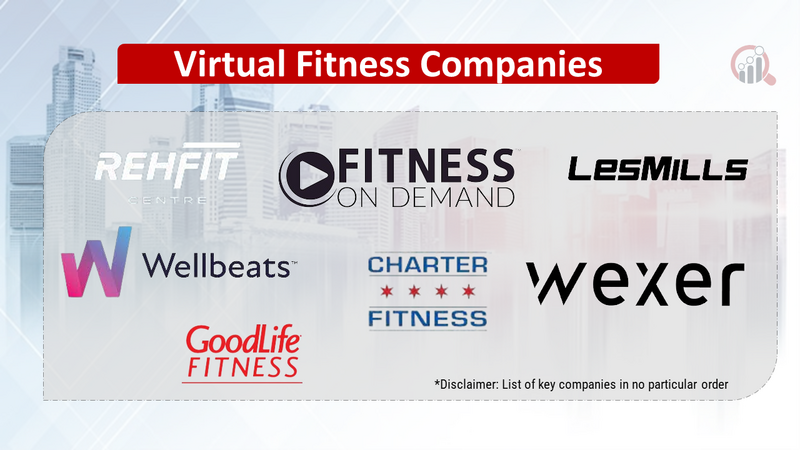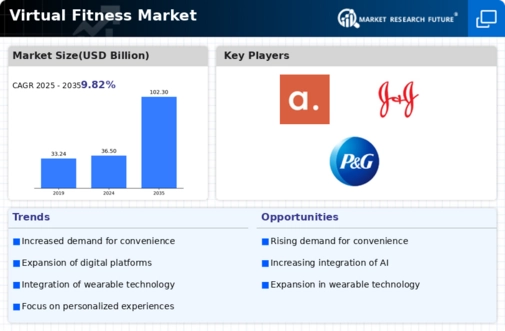Top Industry Leaders in the Virtual Fitness Market

Virtual Fitness Market: Dive into the Latest News and Updates
Gone are the days of gym memberships and crowded locker rooms. The virtual fitness market has revolutionized the way we workout, offering convenience, customization, and personalized training from the comfort of our own homes. This report delves into the dynamic landscape of this booming market. The virtual fitness market is experiencing explosive growth, fueled by the increasing demand for convenient, accessible, and personalized workout experiences.
Some of Virtual Fitness Companies Listed Below:
- Fitness on Demand
- GoodLife Fitness
- Reh-Fit Centre
- Wexer
- LES MILLS INTERNATIONAL LTD
- WELLBEATS
- FitnFast Health Clubs & Gyms
- Conofitness
- Charter Fitness Inc
Strategies Fueling Growth:
-
Content Diversification and Personalization: Providing a wide variety of workout formats (high-intensity interval training, strength training, dance, yoga) and personalized recommendations based on fitness levels and goals caters to diverse user preferences. -
Liveness and Interactivity: Offering live, instructor-led sessions and interactive features like leaderboards and challenges fosters a sense of community and engages users in real-time. -
Mobile-First Design and Seamless Integration: Developing user-friendly mobile apps and integration with smart wearables and home fitness equipment enhances accessibility and convenience for users on the go. -
Focus on Technology and Innovation: Incorporating virtual reality (VR) and augmented reality (AR) experiences, AI-powered workout recommendations, and data-driven insights personalizes training and elevates the user experience.
Market Share Decoding: Key Factors to Consider
-
Content Library and Quality: Platforms offering a vast library of high-quality, engaging workout classes hold an edge in attracting and retaining users. -
Subscription Model and Pricing: Competitive pricing models, flexible subscription options, and free trials attract budget-conscious consumers and encourage user acquisition. -
Technology and User Experience: Platforms with intuitive interfaces, seamless streaming, and integration with wearables and smart devices provide a superior user experience. -
Brand Reputation and Partnerships: Established brands and strategic partnerships with fitness influencers and studios build trust and expand user reach.
New and Emerging Stars: Illuminating the Workout Path
-
AI-Powered Personalization and Coaching: Companies like Fitbod and Freeletics are developing AI-powered virtual coaches that personalize workout plans, provide real-time feedback, and adjust training based on individual progress. -
Gamification and Social Fitness Experiences: Platforms like Zwift and Supernatural are gamifying workouts and incorporating social features, making exercise more fun and competitive, especially for younger generations. -
Micro-Workout and Snackable Fitness: Startups like FitOn and POPSUGAR Fitness are offering short, targeted workouts that fit into busy schedules, catering to time-pressed individuals seeking quick bursts of activity.
Investment Trends: Where the Sweat Equity Flows
-
AI and Machine Learning Development: Investments are pouring into building AI-powered features for personalized training, real-time feedback, and predictive injury prevention. -
VR and AR Integration: Investors are backing companies developing immersive VR and AR workout experiences, blurring the lines between virtual and real-world training. -
Focus on Mental Wellness and Holistic Fitness: With rising demand for holistic well-being, there's increased investment in platforms integrating mindfulness practices, meditation, and mental health resources alongside physical workouts. -
Partnerships and Content Collaborations: Strategic partnerships between virtual fitness platforms, studios, fitness influencers, and wearable technology companies accelerate market growth and content expansion.
Latest Company Updates:
-
October 27, 2023: Peloton acquires the VR fitness platform Supernatural, showcasing the rise of immersive virtual reality workouts. -
September 14, 2023: Apple Fitness+ expands its offerings with new workout programs and partnerships with renowned trainers. -
August 11, 2023: Nike Training Club launches interactive live workouts led by brand athletes, creating a personalized community experience.

